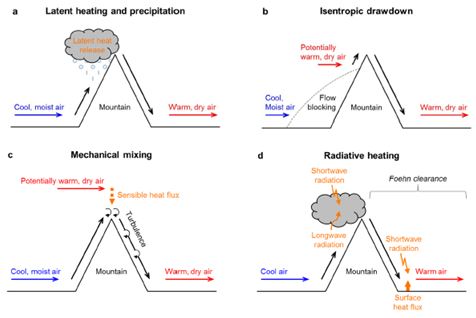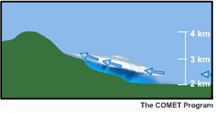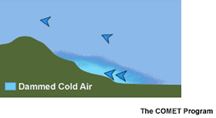Chapter II: Airflow over a mountain
Table of Contents
- Chapter II: Airflow over a mountain
- The Foehn wind
- The Isentropic Drawdown
The Foehn wind
The foehn wind is a downslope wind at the lee side of a mountain that is accelerated, warmed and dried as a result of the orographic disturbance on the prevailing flow (Elvidge, 2016). There are 3 possible mechanisms for foehn warming and drying: the isentropic drawdown (fig 2.1b), the "thermodynamical" foehn (fig. 2.1a) and the mechanical mixing (fig. 2.1c) (Elvidge, 2016). The radiative mixing (fig. 2.1d) is not explicitly considered as foehn mechanism, but is often associated with the previous ones. However, the causes of foehn warming and drying are not fully understood.
Figure 2.1: Foehn warming mechanisms. From (Elvidge, 2016)
In Madeira, the most probable dominant mechanism for the foehn event promoting the ignition and the rapid spread of wildfires is the isentropic drawdown. This is here analysed in more detail. However, the foehn warming can be the result of more than one mechanism at the same time, depending on larger‐scale meteorological conditions and orographically forced flow dynamics.
The Isentropic Drawdown
In this mechanism, the foehn air comes from higher levels (upwind of the mountain barrier) as the low-level flow is blocked by the mountain. The upwind flow can be already warm and dry and the low-level flow is cool and moist. The flow from higher levels is then advected isentropically down the lee slopes.
Orographic blocking occurs when the atmosphere is highly stratified and/or the flow is weak (fig. 2.2). In an isolated mountain, as is the case in Madeira, the low-level air on the upwind side must become stagnant (or reversed), with no winds towards the mountain, and leads to flow channelling around the mountain (fig. 2.3).
Figure 2.2: Orographic blocking (COMET)
Figure 2.3: Orographic blocking and the air aloft flowing over the mountain (COMET)
A possible way of evaluating existing blocking conditions is the use of the Froude number (Fr), which is a nondimensional ratio of the inertial force to the force of gravity for a given fluid flow. In the atmosphere it establishes a relation between wind speed and atmospheric stability.
where U is the mean wind speed (m/s), h is the height of the barrier (m) relative to the height of the air stream and N the upstream Brunt-Väisälä frequency (s-1).
This quantity, not the classical Froude number form, yields a measure of whether there will be an upstream-propagating region of decelerated flow (and, hence, is also sometimes referred to as the Froude number).
For U/(Nh) >> 1, the flow ascends over the obstacle with no upstream deceleration. The air makes it over the mountain.
For U/(Nh) << 1, a region of upstream flow deceleration forms that may propagate continuously upstream with time. The air is blocked by the mountain and must go around or turn back (fig. 2.4).
For consistency with the original definition of Froude, some authors advocate referring to the relation Nh/U (the inverse of Fr as it is defined herein) as the nondimensional mountain height (M).
Figure 2.4: Idealized flow over an isolated hill. The Froude number (Fr) compares the natural wavelength of the air to the width of the hill. Fr = 0.1 (very statically stable)
Source: Forecaster's Reference Book.
It is important to note that the presence of an inversion which can interact with mountain wave features may limit the occurrence of foehn conditions.
In this study, the AROME model will provide information about the Froude number and the non-dimensional mountain height, but ASCAT data may also give a hint of the flow behaviour, like the upwind stagnant and/or reversal air.




